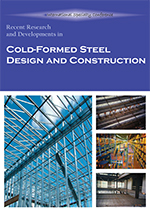Session Dates
24 Aug 2012 - 25 Aug 2012
Keywords and Phrases
Modal identification, constrained finite strip method, shell finite element, elastic buckling analysis, collapse analysis
Abstract
This paper illustrates new capabilities for modal identification of shell Finite Element Method (FEM) models of thin-walled cold-formed steel members. The separation of general deformations into fundamental buckling deformation classes: local, distortional, global, shear, and transverse extension, originated with the constrained Finite Strip Method (cFSM) and is extended here to shell element based FEM analysis. The cFSM base vectors for general end boundary conditions, previously developed by the authors, provide a series of general base functions capable of separating displacements into classes. FEM displacements are identified by minimizing error between the actual FEM displacements and those predicted by the cFSM base functions. This leads to the ability to quantify (i.e., modally identify) the global, distortional, and local participation in a FEM model. The ability to categorize the complicated deformations of a FEM model into simple classes is of great importance because of the different post-buckling and collapse behavior associated with each class. Further, the extension to general FEM models allows for modal identification of members with geometric changes along the length, such as holes, as well as concentrated loads and other characteristics difficult to capture in the finite strip formulation. The method is demonstrated for modal identification of FEM linear elastic analysis, FEM elastic buckling analysis (including highly coupled modes) and FEM nonlinear collapse analysis. Further, the examples include members with holes. The dominance of distortional buckling deformations in collapse regimes of lipped channel members is observed and provides new insight on the interaction of buckling modes in cold-formed steel members. Limitations of the method and future directions for the work are discussed.
Department(s)
Civil, Architectural and Environmental Engineering
Research Center/Lab(s)
Wei-Wen Yu Center for Cold-Formed Steel Structures
Meeting Name
21st International Specialty Conference on Cold-Formed Steel Structures
Publisher
Missouri University of Science and Technology
Document Version
Final Version
Rights
© 2012 Missouri University of Science and Technology, All rights reserved.
Document Type
Article - Conference proceedings
File Type
text
Language
English
Recommended Citation
Li, Z.; Ádány, S.; and Schafer, B. W., "Modal Identification of Cold-formed Steel Members in Shell Finite Element Models" (2012). CCFSS Proceedings of International Specialty Conference on Cold-Formed Steel Structures (1971 - 2018). 1.
https://scholarsmine.mst.edu/isccss/21iccfss/21iccfss-session1/1
Modal Identification of Cold-formed Steel Members in Shell Finite Element Models
This paper illustrates new capabilities for modal identification of shell Finite Element Method (FEM) models of thin-walled cold-formed steel members. The separation of general deformations into fundamental buckling deformation classes: local, distortional, global, shear, and transverse extension, originated with the constrained Finite Strip Method (cFSM) and is extended here to shell element based FEM analysis. The cFSM base vectors for general end boundary conditions, previously developed by the authors, provide a series of general base functions capable of separating displacements into classes. FEM displacements are identified by minimizing error between the actual FEM displacements and those predicted by the cFSM base functions. This leads to the ability to quantify (i.e., modally identify) the global, distortional, and local participation in a FEM model. The ability to categorize the complicated deformations of a FEM model into simple classes is of great importance because of the different post-buckling and collapse behavior associated with each class. Further, the extension to general FEM models allows for modal identification of members with geometric changes along the length, such as holes, as well as concentrated loads and other characteristics difficult to capture in the finite strip formulation. The method is demonstrated for modal identification of FEM linear elastic analysis, FEM elastic buckling analysis (including highly coupled modes) and FEM nonlinear collapse analysis. Further, the examples include members with holes. The dominance of distortional buckling deformations in collapse regimes of lipped channel members is observed and provides new insight on the interaction of buckling modes in cold-formed steel members. Limitations of the method and future directions for the work are discussed.



